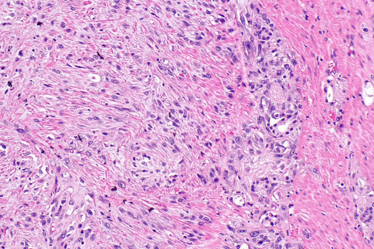From Neurobiology to Prostate Cancer Pathology
Can the drebrin/EB3 pathway be used to predict the invasiveness of the most common cancer in men?
Metastatic prostate cancer is incurable – symptoms can only be managed – and there’s currently no way to predict when or if the disease will metastasize (1). To that end, researchers at King’s College London dug into the mechanisms behind prostate cancer – using knowledge gained in neurobiology – and discovered that the drebrin/EB3 pathway appears to play a role in prostate cancer’s invasiveness (1). Knockdown of either protein’s in vitro expression decreased the ability of the cancer cells to invade the prostrate stroma, while over-expression had the opposite effect. To find out if the pathway could be used as a therapeutic target or a biomarker for progression to metastasis, we speak with Philip Gordon-Weeks, lead investigator and professor of developmental neurobiology at King’s College London.
What do your findings mean for diagnosis and prognosis?
We haven’t cured prostate cancer, but I think we’ve taken a big step in the right direction. A key clinical issue in prostate cancer is predicting which prostate tumors will become metastatic. Evaluating the drebrin/EB3 pathway might help clinicians stratify patients by distinguishing between benign and malignant prostate cancer. However, I don’t think this would be done in isolation – one would want to examine a panel of prognosis predictive biomarkers.
The drebrin/EB3 pathway might also be a suitable target for pharmaceutical disruption. In our paper, we described using a drug (BTP2) that targets drebrin to disrupt prostate cancer cell invasion as a proof-of-principle.

How does a professor of developmental biology end up working on prostate cancer?
Well, we actually discovered the drebrin/EB3 pathway while working on the embryonic development of the nervous system. We found that it enabled embryonic neurons to respond to homing signals in the embryo that helped them to build neuronal circuits. One step in this process involves the migration of new born neurons from their birthplace in the embryonic nervous system to the final position they will occupy in the adult. The event has similarities with cancer cell invasion and metastasis – both involve homing signals and re-organization of the cytoskeleton – and so we wondered whether cancer cells might use the same cellular machinery as neurons to do this.
When we started working on prostate cancer, I thought that we would be on a one-way-street – simply applying all the conceptual insights, reagents and tools that we had worked on in our developmental neurobiology studies to investigate prostate cancer cell invasion. But we also made several unexpected discoveries about the drebrin/EB3 pathway in prostate cancer cells that encouraged us to go back and look again at developing neurons – so we were on a two-way-street after all!
What were the major challenges you had to overcome?
An experimental hurdle for us was trying to mimic the in vivo situation in a tissue culture dish so that we could more easily study cancer cell invasion. This meant setting up 3D cultures with concentration gradients of homing signals. We chose the chemokine CXCL12 as a signal because there is good experimental evidence that it is involved in stimulating prostate cancer cells to invade the prostate stroma and to metastasize to bone (2). We also wanted to test the role of the drebrin/EB3 pathway in metastasis in a pre-clinical in vivo model, but at the time there were none that mimicked bone metastasis.
What’s next?
We are about to apply to the UK’s Medical Research Council for support to continue our work, including exploiting a newly described pre-clinical mouse model of prostate cancer metastasis to test the role of the drebrin/EB3 pathway. These are conceptually simple experiments, but very powerful. We will edit out the drebrin/EB3 pathway in human prostate cancer cell lines using CRISPR/Cas-9, and orthotopically transplant the cells into the prostate of immunocompromised mice. If the transplanted cells multiply but fail to metastasize then this will directly demonstrate the importance of the drebrin/EB3 pathway in prostate cancer cell metastasis.
- AE Dart et al., “The drebrin/EB3 pathway drives invasive activity in prostate cancer”, Oncogene, [Epub ahead of print] (2017). PMID: 28319065.
- RS Taichman et al., “Use of the stromal cell-derived factor-1/CXCR4 pathway in prostate cancer metastasis to bone”, Cancer Res, 62, 1832–1837 (2002). PMID: 119912162.
My fascination with science, gaming, and writing led to my studying biology at university, while simultaneously working as an online games journalist. After university, I travelled across Europe, working on a novel and developing a game, before finding my way to Texere. As Associate Editor, I’m evolving my loves of science and writing, while continuing to pursue my passion for gaming and creative writing in a personal capacity.















